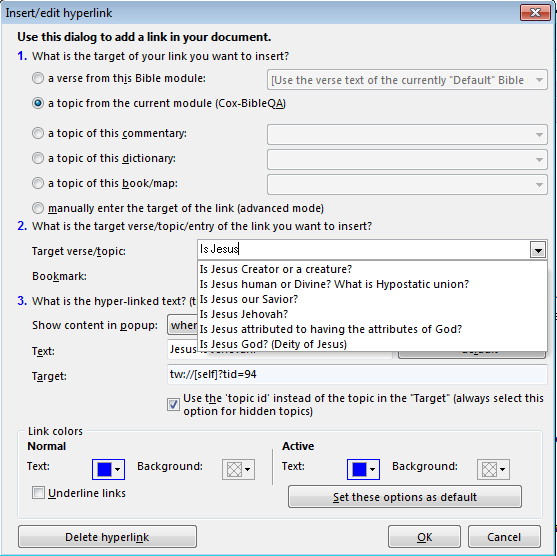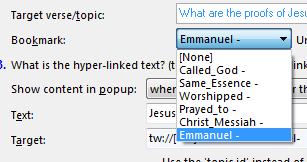Class objective: To make an ebook type topic with an outline and notes, page anchors, and with hyperlinks to these anchors/main subtopics.
theWord hyperlink creation
theWord hyperlink creation. There are many ebook applications out there, one of the best and most popular is a simple Adobe Acrobat file (a pdf file). If properly made, a PDF can have an outline, with a table of contents and each point in it being a hyperlink to that section. There are epub books, and a host of other types of software and formats whereby you can make the material of a book or Bible study into a “public document with navigation”. However, the advantage of theWord over all of these, is that theWord automatically formats and links all Bible references into the Bible, and this default Bible can be switched to any particular version you desire. Many people who use the NIV or some other version as well as missionaries make excellent use of reading an English document but using say a Spanish Bible for the verse references. I personally do this a lot. I can copy and paste the verses in Spanish into some sermon or Bible study I am working on.
See also Setting the Default Bible Version
 .
.
Please help us keep this website up. We work hard to be a blessing to you. Donate to us. Even a $5 or $10 donation is greatly appreciated. All donations will go to pay hosting and domain fees.
You can use your PayPal account if you have one, or you can donate using any normal debit or credit card, pay through PayPal and chose just Debit or Credit Card.
Basically, this is very similar to regular HTML procedures. The way this works is that you first make an anchor somewhere in the page, and then you type text that will be the text of the menu option, and finally to highlight that text and make a hyperlink to the anchor. See my youtube video demostrating this at the bottom of this page.
Making an anchor
The anchor is where TW will go to when you click on the hyperlink, and it is also what will show (starting there to some point further down on the page) in a tooltip when you hover or mouseover the hyperlink.
To make an anchor, you go to where you want the hyperlink to end up at, and press Control R. This should get you the following dialog box.
You will type in the name of the anchor (something that clearly identifies it) or you can use the default name TW suggests (which is bkm plus a number). Frankly I reserve the bkm for footnotes myself.
To delete an anchor already made you go to the anchor in the text (a dotted green line or a small round hollow circle identifies it), and press control + R to access it. Then you click delete, or you can change tabs and delete all the existing anchors in that particular topic.
Making the hyperlink
Once you have the anchor (which is always first), then you go to where you want the link text to be, and type in that. In long complicated topics, I often will take all the major headings and copy and paste them to the top portion of the topic, type in “Topics” and below that insert these topics, make the anchors, and then link the text to them. The video shows how this works.
Once you select the text for your hyperlink, you press control K. You should now see this image.
At this point your highlight text will be in the field “Text” (towards the bottom, in the above image is it under the last line of the popup box). There are two key fields here, the “Target verse/Topic” field and the “Bookmark” field.
In the Target Verse/Topic field you can select a Bible version/verse reference (you will need to change the above options in part 1. to Bible. Here we are leaving the top part and just going to select a topic from the current module. Note that all the topics are in this dropdown box, and you can just click into it and start typing if you know the name of the topic. Since we are not linking outside of the present topic we will leave that alone.
Now click in the Bookmark (anchors) dropdown box. You should see this image.
Here in the bookmark field you can choose which of the anchors on this page you want to make the bookmark or place where TW will go to when you click the hyperlink.
The next field beside it is how much will be seen in the tooltip popup which is displayed when you mouseover or hover over the hyperlink.


